Visibility
It was seen completely over North and South America, seen rising over Australia, and setting over Western Africa.[ citation needed ]
| Total eclipse | |||||||||||||||||
| Date | 6 July 1982 | ||||||||||||||||
|---|---|---|---|---|---|---|---|---|---|---|---|---|---|---|---|---|---|
| Gamma | −0.05792 | ||||||||||||||||
| Magnitude | 1.71795 | ||||||||||||||||
| Saros cycle | 129 (36 of 71) | ||||||||||||||||
| Totality | 105 minutes, 44.5 seconds | ||||||||||||||||
| Partiality | 235 minutes, 36.5 seconds | ||||||||||||||||
| Penumbral | 373 minutes, 57.4 seconds | ||||||||||||||||
| |||||||||||||||||
A total lunar eclipse took place on Tuesday, 6 July 1982, the second of three total lunar eclipses in 1982, and the only one that was in the descending node. A dramatic total eclipse lasting 1 hour and 46 minutes plunged the full Moon into deep darkness, as it passed right through the centre of the Earth's umbral shadow. While the visual effect of a total eclipse is variable, the Moon may have been stained a deep orange or red colour at maximum eclipse. This was a great spectacle for everyone who saw it. The partial eclipse lasted for 3 hours and 56 minutes in total.
The moon passed through the center of the Earth's shadow.[ citation needed ]
It was seen completely over North and South America, seen rising over Australia, and setting over Western Africa.[ citation needed ]
There are seven eclipses in 1982, the maximum possible, including 4 partial solar eclipses: January 25, 20 July, 21 June, and 15 December.
| Lunar eclipse series sets from 1980–1984 | ||||||||
|---|---|---|---|---|---|---|---|---|
| Descending node | Ascending node | |||||||
| Saros | Date Viewing | Type Chart | Gamma | Saros | Date Viewing | Type Chart | Gamma | |
| 109 | 1980 Jul 27  | Penumbral | 1.41391 | 114 | 1981 Jan 20  | Penumbral | −1.01421 | |
| 119 | 1981 Jul 17  | Partial | 0.70454 | 124 | 1982 Jan 09  | Total | −0.29158 | |
| 129 | 1982 Jul 06  | Total | −0.05792 | 134 | 1982 Dec 30  | Total | 0.37579 | |
| 139 | 1983 Jun 25  | Partial | −0.81520 | 144 | 1983 Dec 20  | Penumbral | 1.07468 | |
| 149 | 1984 Jun 13  | Penumbral | −1.52403 | |||||
| Last set | 1980 Aug 26 | Last set | 1980 Mar 13 | |||||
| Next set | 1984 May 15 | Next set | 1984 Nov 08 | |||||
Lunar saros series 129, repeating every 18 years and 11 days, containing 71 events, has 11 total lunar eclipses. The first total lunar eclipse of this series was on May 24, 1910, and last will be on September 8, 2090. The longest occurrence of this series was on July 16, 2000 when totality lasted 106 minutes and 24.6 seconds.
| Greatest | First | |||
|---|---|---|---|---|
 The greatest eclipse of the series occurred on 2000 Jul 16, lasting 106 minutes. | Penumbral | Partial | Total | Central |
| 1351 Jun 10 | 1513 Sep 15 | 1910 May 24 | 1946 Jun 14 | |
| Last | ||||
| Central | Total | Partial | Penumbral | |
| 2036 Aug 7 | 2090 Sep 8 | 2469 Apr 26 | 2613 Jul 24 | |
| 1910 May 24 | 1928 Jun 3 | 1946 Jun 14 | |||
 |  |  |  |  |  |
| 1964 Jun 25 | 1982 Jul 6 | 2000 Jul 16 | |||
 |  |  |  |  |  |
| 2018 Jul 27 | 2036 Aug 7 | 2054 Aug 18 | |||
 |  |  |  |  |  |
| 2072 Aug 28 | 2090 Sep 8 | ||||
 |  |  |  | ||
It last occurred on 25 June 1964 and will next occur on 16 July 2000.
This is the 36th member of Lunar Saros 129. The previous event was the June 1964 lunar eclipse. The next event is the July 2000 lunar eclipse. Lunar Saros 129 contains 11 total lunar eclipses between 1910 and 2090. Solar Saros 136 interleaves with this lunar saros with an event occurring every 9 years 5 days alternating between each saros series.[ citation needed ]
The inex series repeats eclipses 20 days short of 29 years, repeating on average every 10571.95 days. This period is equal to 358 lunations (synodic months) and 388.5 draconic months. Saros series increment by one on successive Inex events and repeat at alternate ascending and descending lunar nodes.
This period is 383.6734 anomalistic months (the period of the Moon's elliptical orbital precession). Despite the average 0.05 time-of-day shift between subsequent events, the variation of the Moon in its elliptical orbit at each event causes the actual eclipse time to vary significantly. It is a part of Lunar Inex series 39.
All events in this series listed below and more are total lunar eclipses.
| Ascending node | Descending node | Ascending node | Descending node | ||||
|---|---|---|---|---|---|---|---|
| Saros | Date | Saros | Date | Saros | Date | Saros | Date |
| 96 | 1027 Apr 23 | 97 | 1056 Apr 2 | 98 | 1085 Mar 14 | 99 | 1114 Feb 21 |
| 100 | 1143 Feb 1 | 101 | 1172 Jan 13 | 102 | 1200 Dec 22 | 103 | 1229 Dec 2 |
| 104 | 1258 Nov 12 | 105 | 1287 Oct 22 | 106 | 1316 Oct 2 | 107 | 1345 Sep 12 |
| 108 | 1374 Aug 22 | 109 | 1403 Aug 2 | 110 | 1432 Jul 13 | 111 | 1461 Jun 22 |
| 112 | 1490 Jun 2 | 113 | 1519 May 14 | 114 | 1548 Apr 22 | 115 | 1577 Apr 2 |
| 116 | 1606 Mar 24 | 117 | 1635 Mar 3 | 118 | 1664 Feb 11 | 119 | 1693 Jan 22 |
| 120 | 1722 Jan 2 | 121 | 1750 Dec 13 | 122 | 1779 Nov 23 | 123 | 1808 Nov 3 |
| 124 | 1837 Oct 13 | 125 | 1866 Sep 24 | 126 | 1895 Sep 4 | 127 | 1924 Aug 14 |
| 128 | 1953 Jul 26  | 129 | 1982 Jul 6  | 130 | 2011 Jun 15  | 131 | 2040 May 26  |
| 132 | 2069 May 6  | 133 | 2098 Apr 15  | 134 | 2127 Mar 28 | 135 | 2156 Mar 7 |
| 136 | 2185 Feb 14 | 137 | 2214 Jan 27 | 138 | 2243 Jan 7 | 139 | 2271 Dec 17 |
| 140 | 2300 Nov 27 | 141 | 2329 Nov 7 | 142 | 2358 Oct 18 | 143 | 2387 Sep 28 |
| 144 | 2416 Sep 7 | 145 | 2445 Aug 17 | 146 | 2474 Jul 29 | ||
A lunar eclipse will be preceded and followed by solar eclipses by 9 years and 5.5 days (a half saros). [1] This lunar eclipse is related to two total solar eclipses of Solar Saros 136.
| June 30, 1973 | July 11, 1991 |
|---|---|
 |  |

A total solar eclipse occurred at the Moon's descending node of orbit between Sunday, November 23 and Monday, November 24, 2003, with a magnitude of 1.0379. A solar eclipse occurs when the Moon passes between Earth and the Sun, thereby totally or partly obscuring the image of the Sun for a viewer on Earth. A total solar eclipse occurs when the Moon's apparent diameter is larger than the Sun's, blocking all direct sunlight, turning day into darkness. Totality occurs in a narrow path across Earth's surface, with the partial solar eclipse visible over a surrounding region thousands of kilometres wide. Occurring about 25 minutes before perigee, the Moon's apparent diameter was near its maximum. Perigee did occur just past the greatest point of this eclipse.

A total lunar eclipse took place on Sunday 16 July 2000, the second of two total lunar eclipses in 2000.

A total lunar eclipse will take place on May 26, 2040. The northern limb of the Moon will pass through the center of the Earth's shadow. This is the second central lunar eclipse of Saros series 131. This lunar event will occur near perigee, as a result, it will be referred to as a "super flower blood moon" or "super blood moon", though not quite as close to Earth as the eclipse of May 26, 2021.

A total lunar eclipse will take place between Monday and Tuesday, June 25-26, 2029. A central total eclipse lasting 1 hour and 41 minutes 53 seconds will plunge the full Moon into deep darkness, as it passes right through the centre of the Earth's umbral shadow. While the visual effect of a total eclipse is variable, the Moon may be stained a deep orange or red color at maximum eclipse. It will be able to be seen from most of the Americas, Western Europe and Africa. The partial eclipse will last for 3 hours and 39 minutes 32 seconds in total.

A total lunar eclipse took place on Saturday, April 13, 1968, the first of two total eclipses in 1968, the second being on October 6, 1968.

A total lunar eclipse took place on Sunday, July 26, 1953.
A total lunar eclipse took place on Monday, September 15, 1913. The moon passed through the center of the Earth's shadow.
A total lunar eclipse took place at the Moon's descending node of the orbit on Tuesday, May 24, 1910 with an umbral eclipse magnitude of 1.09503. A total lunar eclipse takes place when the Earth comes between the Sun and the Moon and its shadow covers the Moon. Eclipse watchers can see the Moon turn red when the eclipse reaches totality. Total eclipses of the Moon happen at Full Moon when the Sun, Earth, and Moon are aligned to form a line. The astronomical term for this type of alignment is syzygy, which comes from the Greek word for being paired together. The Moon does not have its own light but shines because its surface reflects the Sun's rays. During a total lunar eclipse, the Earth comes between the Sun and the Moon and blocks any direct sunlight from reaching the Moon. The Sun casts the Earth's shadow on the Moon's surface. A shallow total eclipse saw the Moon in relative darkness for 49 minutes and 29.5 seconds. The Moon was 9.503% of its diameter into the Earth's umbral shadow, and should have been significantly darkened. The partial eclipse lasted for 3 hours, 35 minutes and 22.9 seconds in total.

A total lunar eclipse will take place on May 6, 2069. The eclipse will be dark, with the southern tip of the Moon passing through the center of the Earth's shadow. This is the first central eclipse of Saros series 132.
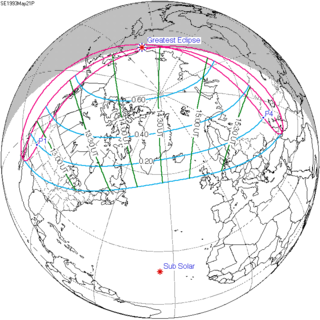
A partial solar eclipse occurred at the Moon's descending node of orbit on Friday, May 21, 1993, with a magnitude of 0.7352. A solar eclipse occurs when the Moon passes between Earth and the Sun, thereby totally or partly obscuring the image of the Sun for a viewer on Earth. A partial solar eclipse occurs in the polar regions of the Earth when the center of the Moon's shadow misses the Earth.
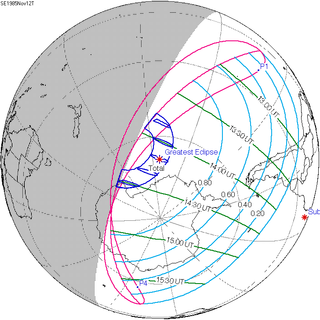
A total solar eclipse occurred at the Moon's descending node of orbit on Tuesday, November 12, 1985, with a magnitude of 1.0388. A solar eclipse occurs when the Moon passes between Earth and the Sun, thereby totally or partly obscuring the image of the Sun for a viewer on Earth. A total solar eclipse occurs when the Moon's apparent diameter is larger than the Sun's, blocking all direct sunlight, turning day into darkness. Totality occurs in a narrow path across Earth's surface, with the partial solar eclipse visible over a surrounding region thousands of kilometres wide. Occurring about 2 hours after perigee, the Moon's apparent diameter was larger. Perigee did occur during the early portion of the eclipse.
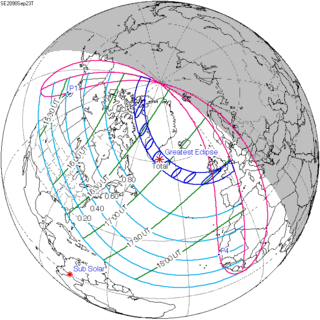
A total solar eclipse will occur at the Moon's ascending node of orbit on Saturday, September 23, 2090, with a magnitude of 1.0562. A solar eclipse occurs when the Moon passes between Earth and the Sun, thereby totally or partly obscuring the image of the Sun for a viewer on Earth. A total solar eclipse occurs when the Moon's apparent diameter is larger than the Sun's, blocking all direct sunlight, turning day into darkness. Totality occurs in a narrow path across Earth's surface, with the partial solar eclipse visible over a surrounding region thousands of kilometres wide. Occurring only about 4 hours after perigee, the Moon's apparent diameter will be larger.
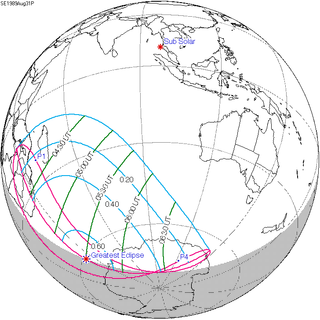
A partial solar eclipse occurred at the Moon's descending node of orbit on Thursday, August 31, 1989, with a magnitude of 0.6344. A solar eclipse occurs when the Moon passes between Earth and the Sun, thereby totally or partly obscuring the image of the Sun for a viewer on Earth. A partial solar eclipse occurs in the polar regions of the Earth when the center of the Moon's shadow misses the Earth.
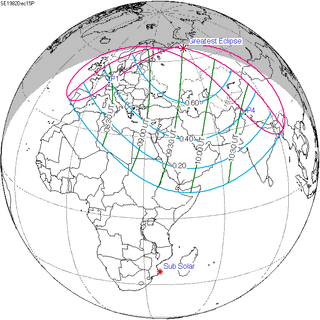
A partial solar eclipse occurred at the Moon's descending node of orbit on Wednesday, December 15, 1982, with a magnitude of 0.735. A solar eclipse occurs when the Moon passes between Earth and the Sun, thereby totally or partly obscuring the image of the Sun for a viewer on Earth. A partial solar eclipse occurs in the polar regions of the Earth when the center of the Moon's shadow misses the Earth.

An annular solar eclipse will occur at the Moon's descending node of orbit on Thursday, October 13, 2061, with a magnitude of 0.9469. A solar eclipse occurs when the Moon passes between Earth and the Sun, thereby totally or partly obscuring the image of the Sun for a viewer on Earth. An annular solar eclipse occurs when the Moon's apparent diameter is smaller than the Sun's, blocking most of the Sun's light and causing the Sun to look like an annulus (ring). An annular eclipse appears as a partial eclipse over a region of the Earth thousands of kilometres wide. Occurring about 1.1 days before apogee, the Moon's apparent diameter will be smaller.
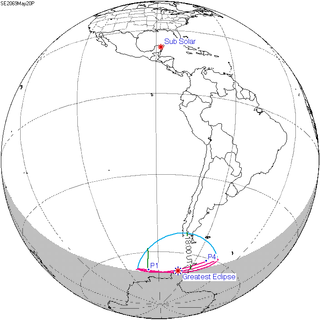
A partial solar eclipse will occur at the Moon's descending node of orbit on Monday, May 20, 2069, with a magnitude of 0.0879. A solar eclipse occurs when the Moon passes between Earth and the Sun, thereby totally or partly obscuring the image of the Sun for a viewer on Earth. A partial solar eclipse occurs in the polar regions of the Earth when the center of the Moon's shadow misses the Earth.
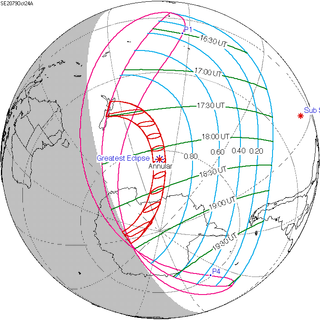
An annular solar eclipse will occur at the Moon's descending node of orbit on Tuesday, October 24, 2079, with a magnitude of 0.9484. A solar eclipse occurs when the Moon passes between Earth and the Sun, thereby totally or partly obscuring the image of the Sun for a viewer on Earth. An annular solar eclipse occurs when the Moon's apparent diameter is smaller than the Sun's, blocking most of the Sun's light and causing the Sun to look like an annulus (ring). An annular eclipse appears as a partial eclipse over a region of the Earth thousands of kilometres wide. Occurring about 5.25 days before apogee, the Moon's apparent diameter will be smaller.

A total solar eclipse will occur at the Moon's descending node of orbit on Saturday, January 16, 2094, with a magnitude of 1.0342. A solar eclipse occurs when the Moon passes between Earth and the Sun, thereby totally or partly obscuring the image of the Sun for a viewer on Earth. A total solar eclipse occurs when the Moon's apparent diameter is larger than the Sun's, blocking all direct sunlight, turning day into darkness. Totality occurs in a narrow path across Earth's surface, with the partial solar eclipse visible over a surrounding region thousands of kilometres wide. Occurring about 10.5 hours before perigee, the Moon's apparent diameter will be larger.

A total solar eclipse will occur at the Moon's descending node of orbit on Tuesday, June 11, 2086, with a magnitude of 1.0174. A solar eclipse occurs when the Moon passes between Earth and the Sun, thereby totally or partly obscuring the image of the Sun for a viewer on Earth. A total solar eclipse occurs when the Moon's apparent diameter is larger than the Sun's, blocking all direct sunlight, turning day into darkness. Totality occurs in a narrow path across Earth's surface, with the partial solar eclipse visible over a surrounding region thousands of kilometres wide. Occurring about 4.4 days after perigee, the Moon's apparent diameter will be larger.

Saros cycle series 129 for lunar eclipses occurs at the moon's descending node, repeats every 18 years 11+1/3 days. The 129th lunar saros is associated with Solar Saros 136.